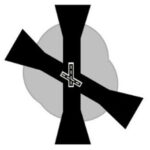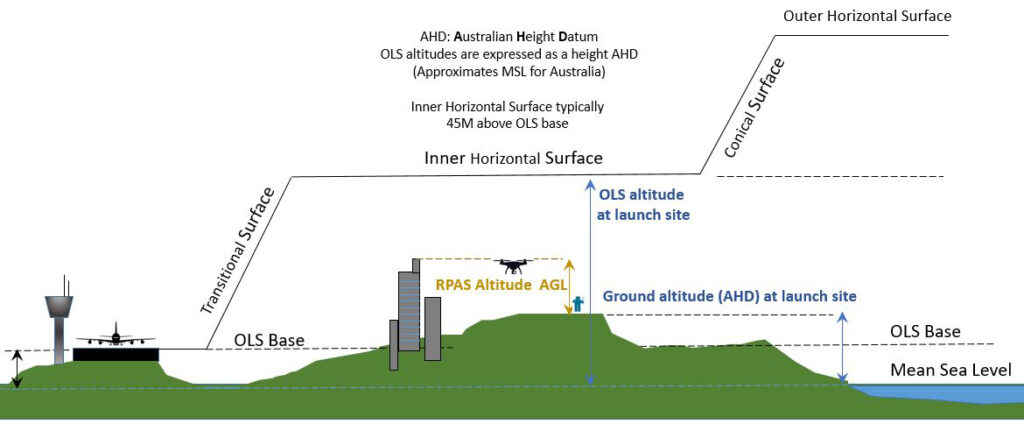Airservices is committed to facilitating the successful entry of RPAS into controlled airspace in a staged process that will integrate with manned operations.
Operational concept – Management of RPAS in ATM operations
Airservices is committed to an inclusive approach to the safe integration of RPAS operations and recognise the opportunities and challenges generated by that the RPAS sector. Airservices is developing the Integrated Airspace Program that will seek to deliver more efficient and suited services to low level airspace users in the near future. Part of this program is to work with CASA to enable automated RPAS approvals for operations that fall within certain parameters.
Operation in controlled airspace
RPAS with advanced equipment levels
In general terms, where the equipment levels and capability of the RPAS reflect those of conventionally piloted aircraft, ATC is responsible for providing a separation service to the RPAS. Generally, the equipment and capability meets this threshold if:
- it is capable of presenting real time information from an certified navigation system;
- is able to maintaining continuous two way communications with ATC; and
- where applicable is equipped with certified surveillance equipment for the airspace in which it will operate.
Note: Portable or fixed installation Electronic Conspicuity (EC) devices (low power equipment able to transmit, and for some devices also receive ADS-B position messages), and Integrated Traffic Awareness Beacon System (TABS) devices (similar to an EC device, but also able to be detected by traffic collision avoidance system (TCAS)) may not be visible to ATC surveillance systems.
RPAS with basic equipment levels
Where the equipment levels and capability of RPAS do not reflect conventionally piloted aircraft, ATC responsibilities are determined by the location and height of the RPAS operation. RPAS operations in controlled airspace do not automatically trigger responsibilities for ATC.
No Fly Zones around controlled aerodromes
The Manual of Standards (MOS) Part 101 depicts no fly zones and approach and departure paths around controlled (and uncontrolled) aerodromes. The no-fly zone of a controlled aerodrome means any areas and airspace that are below 400 ft and:
-
- within 3 NM of the movement area of a controlled aerodrome; or
- within the approach and departure paths referred to in section 4.05, whether or not they extend beyond 3 NM of the movement area of the controlled aerodrome (MOS Part 101 Chapter 4).

All applications for operations within the 'no fly zones' of a controlled aerodrome or above 400FT within controlled airspace must be forwarded to the CASA RPAS Office in the first instance. Visit 'Flying drones/remotely piloted aircraft in Australia' (www.casa.gov.au) for more information. Due to the nature of the operation and/or proximity to the aerodrome, some applications may be rejected or only approved subject to restrictions of, but not limited to, geographic lateral limits, vertical (altitude) limits, a specific time block and specific communication requirements.
Planning your flight
Applicants should review CASA requirements at https://www.casa.gov.au/drones before commencing an application. RPAS operators should also assess the extremities of their operating area to determine which portions of the no fly zones may be infringed. Flights that are within 3NM but do not infringe the grey or black portions of the no fly zones are more likely to be approved without further restriction. Controlled aerodromes are listed in the Designated Airspace Handbook (DAH).
Airservices process applications (to operate within the 'no fly zone' of a controlled aerodrome) based on the risk the operation may pose to conventionally piloted aircraft. The lower the residual risk, the greater the likelihood that the application will be approved. In order to reduce the risk to a minimum, the following should be taken into consideration.
- Operations that are on an extension of a runway centreline pose far greater risk than those that are not.
- Operations that are away from the extended runway centrelines and below the Obstacle Limitation Surface (OLS) of the aerodrome are more likely to be approved with minimal restriction.
- The RPAS is considered to be constrained below the OLS when:
- it is tethered below the OLS altitudes
- it is operating in close proximity to and below the height of a nearby obstacle that is below the OLS.
- for DJI RPAS, on board altimetry (following correction applied by Airservices based on flight time) indicates levels below the OLS.
- Where an operation penetrates the OLS there is an increased risk to conventionally piloted aircraft. These operations must be either:
- Shielded: An operation that is within 100m laterally of, and below an adjacent obstacle
- Segregated from conventionally piloted aircraft laterally or vertically; or
- Managed between conventionally piloted aircraft movements
Note: The following and diagrams are representative of the OLS for each aerodrome. For confirmation of accuracy and currency of the information, please contact the aerodrome operator.
| Adelaide | Albury | Alice Springs | Avalon |
| Bankstown | Brisbane OLS | Cairns | Camden |
| Coffs Harbour | Essendon | Jandakot | Karratha |
| Parafield | Rockhampton | Sydney | Tamworth 1 | Tamworth 2 |
Drone noise
New noise regulations apply to drones. The Department of Infrastructure, Transport, Regional Development and Communications administer the drone noise regulations. Visit the Department’s website for more information about the changes.
Aircraft priorities
Aircraft priorities at controlled aerodromes are contained in the Aeronautical Information Publication Australia (AIP) ENR 10 Regulation of Flight – Assessment of Priorities.
RPAS surveillance
Increasingly, steps are being taken to monitor RPAS traffic in the vicinity of their aerodromes through passive surveillance systems. Currently Airservices has deployed passive surveillance at all 29 controlled aerodromes in order to understand current levels of risk from RPAS. This system will be enhanced and expanded over time.
Future Airspace Management
Airspace is being transformed at a rapid rate by the emergence of new technologies that will allow products, services and aid to reach people and places faster.
See https://www.airservicesaustralia.com/about-us/innovation-and-technology/future-airspace-management/
More information
See CASA https://www.casa.gov.au/drones for additional information including links to legislation, advisory circulars, guides to recreational and commercial flying, safety brochures, and forms.
See Australian Transport Safety Bureau (ATSB) for information on RPAS safety and occurrence reporting.
